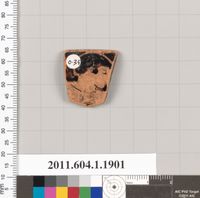
Terracotta oil lamp
An item at Metropolitan Museum of Art
Loeschcke Type 1A. Mold-made. Discus: maenad, advancing right, with head thrown back, arms outstretched, and drapery flowing behind; in her proper left hand a small, indistinct object (castanets: krotala?) and in her right a large round object (tambourine?); a single filling hole at right; a fine band of lines and grooves around edge. Volutes flanking broad, angular nozzle, with large wick hole. Raised base ring, and slightly concave base. One large hole in discus at left, and a small hole in left side of body.
Greek and Roman Art
An exhibit at Metropolitan Museum of Art
The Museum's collection of Greek and Roman art comprises more than thirty thousand works ranging in date from the Neolithic period (ca. 4500 B.C.) to the time of the Roman emperor Constantine's conversion to Christianity in A.D. 312. It includes the art of many cultures and is among the most comprehensive in North America. The geographic regions represented are Greece and Italy, but not as delimited by modern political frontiers: Greek colonies were established around the Mediterranean basin and on the shores of the Black Sea, and Cyprus became increasingly Hellenized. For Roman art, the geographical limits coincide with the expansion of the Roman Empire. The department also exhibits the art of prehistoric Greece (Helladic, Cycladic, and Minoan) and pre-Roman art of Italic peoples, notably the Etruscans.




